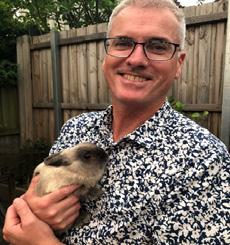
5 minute read
Obituary: Alexander de Lahunta
OBITUARY
ALEXANDER (SANDY) DE LAHUNTA (1932 - 2021)
Image: https://vets.nysvms.org It is with utmost sadness that I share with readers the news that Dr Alexander (Sandy) de Lahunta, Professor Emeritus, Cornell University, NY, passed away in New Hampshire, USA, yesterday. Although many readers of EVP will not have known Sandy de Lahunta very well, probably all would be familiar with his gigantic contribution to veterinary neurology, world-wide, perhaps mostly through five editions of Veterinary Neuroanatomy and Clinical Neurology.
My relationship with Sandy de Lahunta began when I was fortunate enough to undertake graduate studies in veterinary neurology at Cornell University in 1974 under his mentorship. Because Sandy’s working days ran from 3:00 am till 4:30 pm, I needed to commit to early starts to attempt to follow his jetpropelled working habits and most importantly to benefit from his remarkable mentorship in guiding me through the – then new to me – complex though exciting disciplines of neurology and neuropathology. It should be noted that at the stage of me taking up postgraduate studies I was a very naive and reserved student from the other side of the world. Dr de Lahunta was never phased by this incognizance and proceeded to feed my enquiring mind with exciting questions and scenarios that so stimulated my intelect that I have continued to this day trying to emulate his imposing, logical and detailed approach to veterinary neurology and to comparative neuropathology. Through Sandy’s greathearted approach to learning I gained sufficient intellectual assurance to rub shoulders with specialist clinicians and pathologists while still studying at Cornell. I am certain that I could not have achieved this academic assurance without the mentorship from such a great academician and teacher. Three specific aspects of academic training I received from Sandy that I remember most vividly are efficiency, accuracy and toil. These attributes were passed on by Sandy, usually at an early hour, over a double-headed microscope, when this particular ingenuous, though inquisitive, graduate student would pester his mentor with thoughtful posers regarding neurologic clinico-pathologic correleates. Training in this component of neuroscience is what has stood me in good stead through my career, and I believe is what has been of great joy to so, so many of Sandy’s students and colleagues. There is ample evidence of Sandy de Lahunta making a lifelong contribution to education, training and research in veterinary neuroscience by referring to the 5th edition (2020) of the seminal text on Veterinary Neuroanatomy and Clinical Neurology, and to both an early [J Am Vet Med Assoc, 1967; 150(9): 994-1011] and a recent [J Comp Pathol, 2020; 178: 1-8] publication on novel veterinary neurologic disorders, demonstrating a remarkable publication record spanning more than five decades. Alone, and in collaboration with Cornell colleagues, he has published five leading text books and is the author of close to 300 peer reviewed publications in professional and scientific journals. He also is renowned as an exceptional educator. Within the Cornell Veterinary College he was four times the recipient of the Norden Distinguished Teacher Award. In 1991, he was recognized by the American Veterinary Student Association as the Best Teacher in basic sciences. In 2000, he received the Robert W. Kirk Distinguished Service Award of the American College of Veterinary Internal Medicine, and has been granted honorary membership by the American College of Veterinary Pathologists (2002) and the Royal College of Veterinary Surgeons (2005). Finally, this year Sandy was the inaugural recipient of the ACVIM Specialty of Neurology Lifetime Achievement Award. Through tears of sadness and respect, I offer my spiritual thoughts to one of veterinary medicines giants. I.G Joe Mayhew 18 August 2021
AU Wong D et al. Evaluation of a continuous glucose monitoring system in neonatal foals. J Vet Int Med. ; 35 (4): 1995-2001. DOI 10.1111/jvim.16186
A commercial human continuous glucose monitoring systems [CGMS; DEXCOM] was placed on 4 healthy and 4 ill neonatal foals, and these glucose measurements were compared to simultaneous measurements of blood glucose concentration using a point-of-care [POC] AlphaTRAK® glucometer and to using standard laboratory chemistry enzymatic laboratory [CHEM] method resulting in 200 matched glucose measurements (78-212 mg/dL; 4.3-11.8 mmol/L). The Pearson correlation coefficient (r) was significantly correlated among all devices: GCMS and CHEM (r = 0.81); CGMS and POC glucometer (r = 0.77); and POC glucometer and CHEM (r = 0.92). This indicates that CGMS measurements are an acceptable method to provide meaningful, immediate, and continuous glucose concentration measurements in neonatal foals.
Isgren CM. Improving clinical outcomes via responsible antimicrobial use in horses. Eq Vet Edu. June 2021; DOI 10.1111/eve.13502
Extended-spectrum beta-lactamase (ESBL) producing Enterobacteriaceae, methicillin-resistant Staphylococcus aureus (MRSA) and Salmonella spp. are pathogens of significant concern but there are also other opportunistic pathogens such as Pseudomonas spp., alpha-haemolytic Streptococcus spp., Enterococcus spp. and Acinetobacter spp. which, due to their high intrinsic resistance, have limited treatment options in adult horses. It is essential that highest priority, critically important antimicrobials such as ceftiofur, enrofloxacin, rifampicin and polymyxin B are used prudently, with use based on culture and susceptibility testing. A few points in this paper are highlighted: • The use of polymyxin B at a low, anti-endotoxic dose for treatment of systemic inflammatory response syndrome (SIRS) is a potential driver for resistance to colistin (polymyxin E), an antimicrobial used as a last resort in the treatment of multidrug resistant (MDR) Enterobacteriaceae infections in humans. • Serum procalcitonin levels are used in humans to distinguish non-infectious inflammatory conditions from inflammation caused by bacteria and other infectious agents and are also used to guide cessation of antimicrobial treatment. This and other markers may prove to be helpful in guiding antimicrobial treatment decisions in the future. • Optimising sampling techniques, such as sampling from a venous drainage site from localised sepsis and carotid sampling for cases of suspected endocarditis, as well as good communication with the microbiology laboratory, are essential for generating accurate cultures and sensitivity results that underpin appropriate antimicrobial use. • There is clearly a need for national and international harmonisation of laboratory methods in order to improve the reliability and consistency of results reported by different laboratories.
BRIAN GOULDEN AWARD New Zealand Equine Veterinary Association
The Brian Goulden Perpetual Trophy will be awarded annually and presented at the Annual Dinner of the NZEVA conference. This annual prestigious prize is awarded to members or past members of the NZEVA who have shown leadership, enterprise, contribution to knowledge or education, and have made significant contributions to the equine veterinary profession in New Zealand. Please send your nomination including name, address and qualifications, together with any supporting information for the nominee, whom the nominator considers merits the award. This can include curriculum vitae, letters of support and documentation of achievements etc. Send all details AT ANT TIME to nzevasecretary@gmail.com. Brendon Bell NZEVA President
nzevapresident@gmail.com







